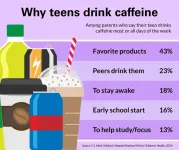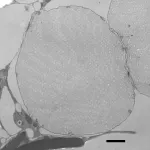(Press-News.org) ANN ARBOR, Mich. – A quarter of parents report that caffeine is basically part of their teen’s daily life, according to a national poll.
Two in three parents think they know whether their teen’s caffeine intake is appropriate and which products have too much caffeine. Yet a third aren’t able to identify recommended caffeine limits, according to the University of Michigan Health C.S. Mott Children’s Hospital National Poll on Children’s Health.
“Our report suggests parents may not always be aware of how much they should be limiting caffeine consumption for teens,” said poll co-director and Mott pediatrician Susan Woolford, M.D.
“Even for parents who know the recommendations, estimating their teen’s caffeine intake can be challenging.”
Soda is teens’ top caffeinated product of choice, according to the nationally representative report that’s based on responses from 1,095 parents of teens polled in February.
Tea and coffee came in as the second most popular caffeine source while less than a fourth of parents said their teen consumed energy drinks.
“Caffeine is a drug that stimulates the brain and nervous system, and too much of it can contribute to a variety of health problems in young people,” Woolford said.
“Teens’ brains are still developing, and excessive caffeine consumption can affect their mood, sleep, and school performance, along with other side effects. They can also become dependent over time, as is true for other drugs.”
What drives caffeine consumption among teens
Two in five parents whose teens consume caffeine most or all days of the week say their teen has it because it’s in their favorite product while less than a fourth say it’s because their peers drink it.
Fewer parents believe their teen drinks caffeine to stay awake during the school day, manage an early school start time or help with studying or focus.
“As parents appear to suggest that teens consume caffeine more for the taste than for the stimulant effect, it may be possible for parents to encourage the use of similar tasing options that are caffeine free,” Woolford said. “But parents may not even be aware that kids are drinking several caffeinated drinks a day and how it’s adding up.”
The good news, Woolford notes, is that the most common place teens consume caffeine is at home followed by dining out, making it easier for parents to intervene and help their teens reduce their caffeine intake. Just a third of teens consume caffeine with friends and a quarter consume it while in school, according to the report.
Woolford shares more findings from the poll and her top tips for monitoring caffeine in teens:
Know recommended caffeine limits
For healthy adults, 400 milligrams of caffeine per day is not generally associated with dangerous effects, according to the U.S. Food and Drug Administration. But the FDA has not given guidance for teens due to insufficient evidence, Woolford says.
The American Academy of Pediatrics also discourages caffeine intake by children and adolescents, and other experts suggest a limit of 100 milligrams per day for teens.
However, one in three parents polled thought the recommended daily limit was higher, Woolford says.
Monitor caffeine levels in your teen’s favorite foods and beverages
Sixty percent of parents polled say they’ve heard about the risks of highly caffeinated products but roughly half say they rarely look at caffeine amounts when buying beverages for their teen.
An 8-ounce cup of coffee has about 100 milligrams of caffeine, but the range of sizes and types of coffee drinks include many with excessive caffeine amounts, Woolford notes. Sodas, sports drinks and even certain brands of water can contain substantial amounts of caffeine.
Energy drinks are also consumed by teens, but a single one may contain up to 500 mg of caffeine along with added sugars.
Caffeine is also found in products that parents might not suspect, Woolford points out, such as gum, snack bars, and over-the-counter pain relievers.
“Parents can reduce their child’s risk of becoming caffeine dependent by checking product labels before purchasing any of these items for their family,” Woolford said.
Watch for signs your teen is overconsuming caffeine
People’s reactions to caffeine often depends on weight, gender, and caffeine sensitivity.
Common side effects from overconsumption may include insomnia, headaches, irritability and nervousness. Unfortunately, reducing or eliminating caffeine consumption may induce the same types of symptoms during withdrawal.
The effect of caffeine also wanes over time, Woolford notes, requiring higher amounts to get the same impact and increasing the risk of negative side effects.
“If your teenager regularly consumes caffeine and is having a hard time sleeping or if they appear jittery, you should take a closer look at whether their caffeine intake is too high,” Woolford said.
Model healthy caffeine consumption
Two-thirds of parents polled say they themselves consume caffeine most or all days of the week. A third have tried to cut back on their caffeine intake while 16% say their teen has tried to reduce caffeine consumption.
Many parents who report their teen consumes caffeine 0-3 days per week say that the family does not usually have caffeinated drinks at home or that the teen is trying to be healthy.
“Parents who have reduced their own caffeine consumption can draw on their experiences to help their teen establish a plan to cut back slowly to avoid withdrawal effects,” Woolford said.
Talk to your teen about caffeine
More parents of teens 16-18 years than 13-15 years report their teen has daily caffeine consumption.
The majority of parents think their teen has heard about the risks of too much caffeine from parents or other family members while others think they’ve learned about unhealthy caffeine levels from teachers, coaches, other school staff or a healthcare provider.
But it’s important that parents also have conversations with teens who may select caffeinated beverages from their school vending machines or spend their own money on caffeinated products.
“Parents should consider talking with their teen about the negative impact of excessive caffeine, and then explore non-caffeinated options they can try together at home, at school or when out with friends,” Woolford said. “Parents may also enlist the teen’s healthcare provider in explaining the risks of caffeine and suggesting strategies to cut back.”
END
1 in 4 parents say their teen consumes caffeine daily or nearly every day
Are parents asleep on their teens’ caffeine intake? National poll suggests some may be unaware of how much caffeine is too much for kids
2024-05-20
ELSE PRESS RELEASES FROM THIS DATE:
What makes some brown algae shimmer and others not?
2024-05-20
Compartments of consistently sized, tightly packed microspheres are what makes some brown algae shimmer like opal. The Kobe University discovery not only sheds light on the mechanism behind the alga’s structural coloration, it is also the first to spot the effect in an order of brown algae other than the two where it was known to occur.
Most brown algae are indeed yellowish-brown, but scuba divers noticed that a species resembling Sporochnus in the order Sporochnales shimmers like peacock feathers in yellow, ...
Seeking stronger steel, systematic look at 120 combinations of alloy elements provides clues
2024-05-20
Decarbonization of automobiles not only requires a shift from gasoline engines to electric motors, but also quality steel parts that help the motors run while lessening the weight of vehicles. High-performance steel materials can offer quieter rides and resist the wear and tear from high-speed rotation in motors. To create them, the process of modifying the steel surface with carbon, nitrogen, and alloy elements needs to be optimized.
To understand the interactions between elements in steel, a systematic investigation ...
Tricking the Brain’s inner GPS: Grid cells responses to the illusion of self-location
2024-05-20
Dr. Hyuk-June Moon from the Bionics Research Center at the Korea Institute of Science and Technology (KIST), in collaboration with Prof. Olaf Blanke’s team at the Swiss Federal Institute of Technology Lausanne (EPFL), has successfully induced self-location illusions with multi-sensory virtual reality (VR) in the MRI scanner and observed corresponding changes in the human brain's grid cell activity.
The brain is known to contain grid cells and place cells, which perform global positioning system (GPS) functions that allow us to recognize where we are. While ...
Gallbladder cancer rises among Black Americans as cases decline in other groups
2024-05-20
WASHINGTON, DC (May 20, 2024) — Gallbladder cancer rates have been stable or declining for most Americans over the last two decades, but cases have steadily risen among Blacks, with growing numbers not being diagnosed until later stages, according to a study scheduled for presentation at Digestive Disease Week® (DDW) 2024.
“Gallbladder cancer diagnosis at late stage can be highly detrimental,” said lead author Yazan Abboud, MD, internal medicine resident at Rutgers University New Jersey Medical School. “This could be due to a lack of timely ...
Biomarker for gastric cancer and other cancer studies set for digestive disease week
2024-05-20
Washington (May 14, 2024) — Cancer-related studies, including a diagnostic tool for gastric cancer and trends in gallbladder and colorectal cancers, will be presented this week at Digestive Disease Week (DDW) 2024. Abstracts are available to registered media, and press releases are available where noted. Studies are embargoed until 12:01 a.m. EDT the day of presentation, unless otherwise noted.
Here are summaries of the new research on the schedule:
Oral microbiome signatures as potential biomarkers for gastric cancer risk assessment, Abstract 949, will be presented Monday, May 20, at 4:15 p.m. EDT. (A press release is available upon request. Embargoed until 12:01 a.m. EDT ...
Endoscopic studies presented at Digestive Disease Week
2024-05-20
Washington (May 14, 2024) — Studies featuring endoscopic and laparoscopic procedures, including patient views on artificial intelligence in endoscopy and hazards to healthcare personnel of smoke-producing procedures, will be presented this week at Digestive Disease Week (DDW) 2024. Abstracts are available to registered media, and press releases are available where noted. Research is embargoed until 12:01 a.m. EDT the day of presentation, unless otherwise noted.
Here are summaries of the new research:
Patients’ sentiments ...
Hunger hormone, antibiotic-induced weight gain, and sleep and digestive health explored at Digestive Disease Week
2024-05-20
Washington (May 14, 2024) — Studies exploring the hunger hormone, weight-loss drugs, sauerkraut and antibiotic weight gain, the impact of physician gender on care, and the relationship between sleep patterns and digestive diseases will be presented this week at Digestive Disease Week (DDW) 2024. Abstracts are available to registered media. Embargos lift at 12:01 a.m. EDT on the day they are presented unless otherwise noted.
Here are summaries of the new research:
Performance of a machine-learning gene ...
Innovative 3D printing could revolutionise treatment for cataracts and other eye conditions
2024-05-20
Peer-reviewed – Proof-of-concept study
University of East Anglia researchers have made a significant breakthrough in ocular device technology with the introduction of a novel resin for 3D printing intraocular devices. This innovation has potential to enhance the manufacture of eye implants universally used in cataract and refractive surgeries.
An artificial intraocular lens (IOL) is primarily required for people with cataracts, a condition where the eye’s natural lens becomes cloudy, obscuring vision.
They can also be also used to correct refractive errors such as myopia (nearsightedness), ...
Rigid approach to teaching phonics is ‘joyless’ and is failing children, experts warn
2024-05-20
Experts have released robust research to show that phonics should be taught hand-in-hand with reading and writing to encourage true literacy and a love of reading, not through narrow synthetic phonics.
There is widespread disagreement globally across academic and educational spheres about the best way to teach children to learn to read and write. Despite a growing international trend towards a narrow approach to synthetic phonics, experts suggest there is a ‘better way’ to teach reading and writing.
In England, the system is among the most prescriptive in the world with ‘synthetic phonics’ being the ...
Meerkat chit-chat
2024-05-20
EMBARGOED UNTIL MONDAY, 20 MAY 2024, 01:01 CEST (00:01 BST/London Time)
Meerkats use two different types of vocal interactions to stay in touch with their group mates. Sometimes the call simply broadcasts information, whereas other times meerkats engage in a call exchange with their neighbours, as researchers from the Centre for the Advanced Study of Collective Behaviour at the University of Konstanz and the Max Planck Institute of Animal Behavior present in a new publication published on 20 May in Philosophical Transactions of the Royal Society B.
What does it sound like ...
LAST 30 PRESS RELEASES:
Injectable breast ‘implant’ offers alternative to traditional surgeries
Neuroscientists devise formulas to measure multilingualism
New prostate cancer trial seeks to reduce toxicity without sacrificing efficacy
Geometry shapes life
A CRISPR screen reveals many previously unrecognized genes required for brain development and a new neurodevelopmental disorder
Hot flush treatment has anti-breast cancer activity, study finds
Securing AI systems against growing cybersecurity threats
Longest observation of an active solar region
Why nail-biting, procrastination and other self-sabotaging behaviors are rooted in survival instincts
Regional variations in mechanical properties of porcine leptomeninges
Artificial empathy in therapy and healthcare: advancements in interpersonal interaction technologies
Why some brains switch gears more efficiently than others
UVA’s Jundong Li wins ICDM’S 2025 Tao Li Award for data mining, machine learning
UVA’s low-power, high-performance computer power player Mircea Stan earns National Academy of Inventors fellowship
Not playing by the rules: USU researcher explores filamentous algae dynamics in rivers
Do our body clocks influence our risk of dementia?
Anthropologists offer new evidence of bipedalism in long-debated fossil discovery
Safer receipt paper from wood
Dosage-sensitive genes suggest no whole-genome duplications in ancestral angiosperm
First ancient human herpesvirus genomes document their deep history with humans
Why Some Bacteria Survive Antibiotics and How to Stop Them - New study reveals that bacteria can survive antibiotic treatment through two fundamentally different “shutdown modes”
UCLA study links scar healing to dangerous placenta condition
CHANGE-seq-BE finds off-target changes in the genome from base editors
The Journal of Nuclear Medicine Ahead-of-Print Tip Sheet: January 2, 2026
Delayed or absent first dose of measles, mumps, and rubella vaccination
Trends in US preterm birth rates by household income and race and ethnicity
Study identifies potential biomarker linked to progression and brain inflammation in multiple sclerosis
Many mothers in Norway do not show up for postnatal check-ups
Researchers want to find out why quick clay is so unstable
Superradiant spins show teamwork at the quantum scale
[Press-News.org] 1 in 4 parents say their teen consumes caffeine daily or nearly every dayAre parents asleep on their teens’ caffeine intake? National poll suggests some may be unaware of how much caffeine is too much for kids





